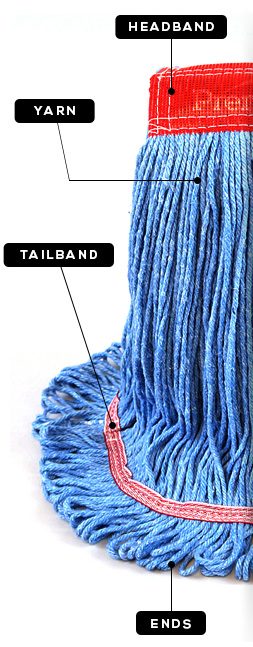Wet mopping is among the most effective cleaning process for the control of heavy dirt and dust. In heavy traffic areas during wet weather or in places where disinfectants or germicides are used, the wet mop is the perfect tool. Premier Mop & Broom offers a wide variety of wet mop designs and fibers for any wet or damp cleaning job.
Looped-End Mops
Economical mop that will not fray or ravel. With proper laundering, these mops will last 10x longer than cut-end mops.
Yarn
Cotton, Rayon, Synthetic, Blended yarn, Microfiber and Microfiber/Synthetic blends are perfectly suited for different cleaning applications
Tailband
Woven 1/2″ tape sewn toward the bottom of the mop to secure the yarn and prevent tangling. Cleans 50% more floor per stroke and mops evenly without leaving gaps for faster mopping and lower labor cost. Standard on all looped-end mops
Cut-End Mops
Economical, general purpose floor mops. These popular product are non-launderable and do not last as long as looped-end mops.
Headband
5″ vinyl headband is secured to the mop with 6 rows of lock-stitching and back-tacked to properly secure headband to mop. The mesh headband offers greater durability and allows the yarn to dry thoroughly
AntiMicrobial
Antimicrobial additive is locked into the yarn to inhibit the growth of bacteria, mold, mildew and fungi that cause odors and stains and shorten product life
 Premier Mop & Broom Mop Construction - Head Band, yarn, Tail Band, Ends
Premier Mop & Broom Mop Construction - Head Band, yarn, Tail Band, EndsFACTORS IN MOP SELECTION
Absorbency
The absorbency of a mop refers to its ability to pick up and hold liquid. Higher levels allow floors to dry faster leading to greater productivity and worker safety. Microfiber, Rayon and Cotton yarns have the highest absorbency
Durability
The durability of a mop is a measure of how long it will perform before needing to be replaced. Microfiber, Synthetic Blend and Cotton/Synthetic Blend are the most durable. Mops with antimicrobial fibers have greater durability because they inhibit the bacterial growth that causes mop odor, discoloration and mildew that breaks down fiber
Launderability
The launderability of a mop is based on the number of commercial washing and drying cycles it can withstand before the construction of the mop is degraded or the performance declines. Microfiber, Synthetic Blend and Cotton/Synthetic Blend mops have the highest levels of launderability
Release
Release is the ability of a mop to disperse liquid onto the floor or during wringing. Higher levels allow faster and more complete wringing as well as more efficient application of cleaning solutions on the floor. Microfiber, Rayon and Cotton Synthetic Blend yarns offer the best release of liquids
Terminologies on Wet Mopping
Cotton, rayon, synthetics and blend all have particular characteristics that make them more suited for one job than another. The table below gives advantages and disadvantages for each type of yarn and suggest the best likely usage of them.
Yarn ply indicates the number of strands twisted together to make a single yarn. More plies give added strength although high ply numbers do not necessarily mean higher quality yarn. More strands may add strength but they may also decrease absorbency. It is better and more cost-effective to choose a higher quality yarn than a high-ply, low quality yarn.
Twist is how tight the strands are twisted together. A yarn with a tight twist may be stronger and last longer but it’s absorbency may be reduced. Like yarn ply, twist is not as important as selecting a good quality yarn or choosing looped-end construction which allows a looser twist without fraying or de-plying.
To get the best value in wet mops it is important to understand the different constructions available. The quality and purpose of a wet mop is just as much a function of construction as yarn type. Superior quality looped end style mops are usually the best value.
Cut-end or the conventional wet mop is popular because of it’s low initial cost. This, however is a false economy. Due to their poor performance characteristics, cut end mops leave gaps, trail of lint and loose threads. Since cut end mops cannot be laundered, they remain dirty and are usually thrown away long before their life is over.
Initially, looped end mops are a little more expensive but their superior quality means substantial improvement in both life and performance. The continous loop construction has several advantages over cut-end mops. It provides higher retention of liquids and faster break-in. Since linting and deplying are virtually eliminated, mops last much longer, yarns have a looser, more absorbent twist resulting in cleaner floors with less labor.
Headbands are available in 1″ for quick-change type handles and finishing applications and 5″ widths for scrubbing.
The 5″ headband is compatible with quick-change and Kwik Grip handles. Headbands are constructed of a synthetic mesh material to allow for quick drying of yarns and provide non abrasive scrubbing. Extra stitching assures durability.
To distinguish mops from others, colored yarn is often used. Color coding programs can designate the mop’s purpose, size or area in which it is used. Hospitals often color code mops to prevent transmittal of disease. The use of colored yarn also keeps mops looking new and clean and eliminates the need for caustic chemicals when washing.
The operators physical size and strength should properly match the suggested mop size to prevent worker fatigue and low productivity.





Comments are closed.